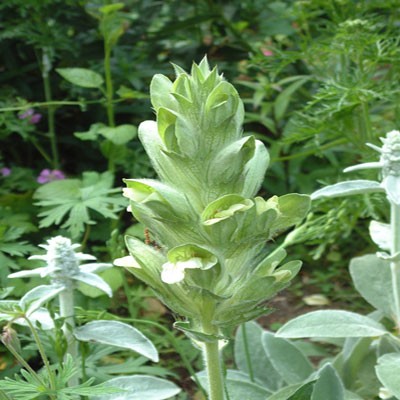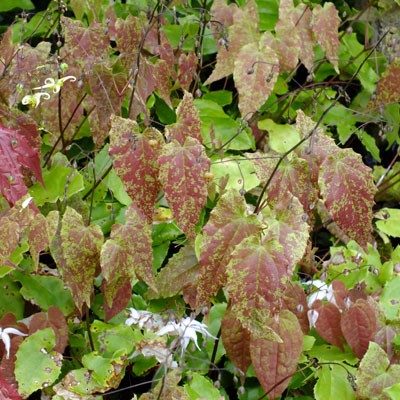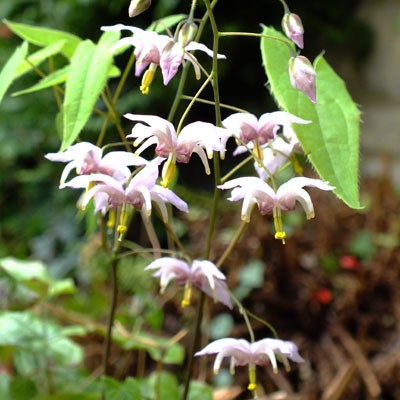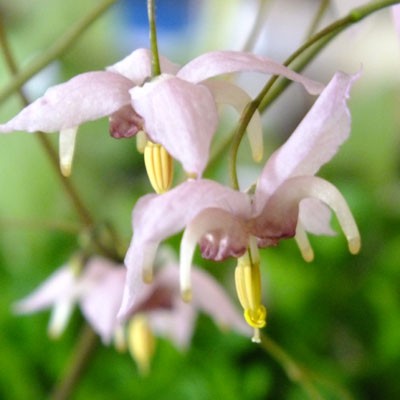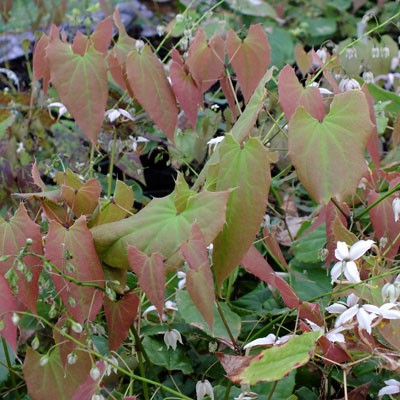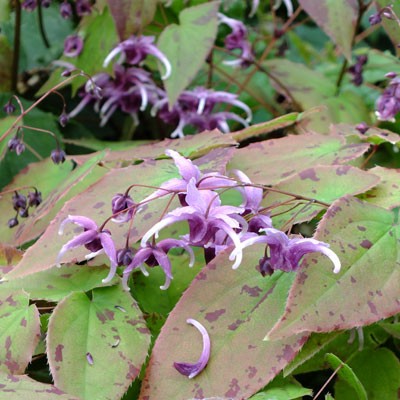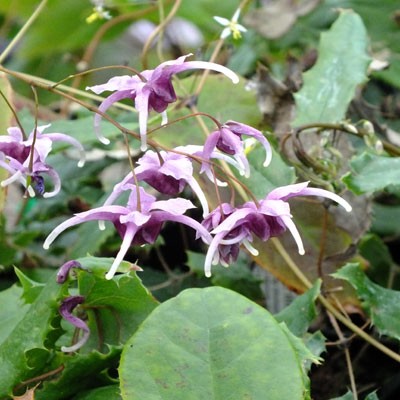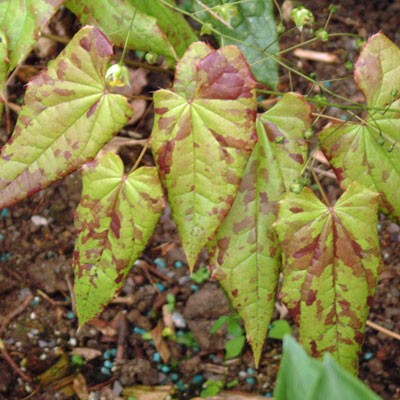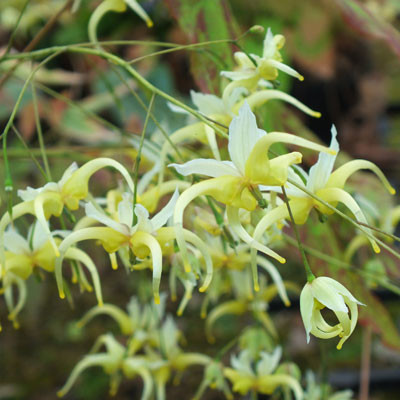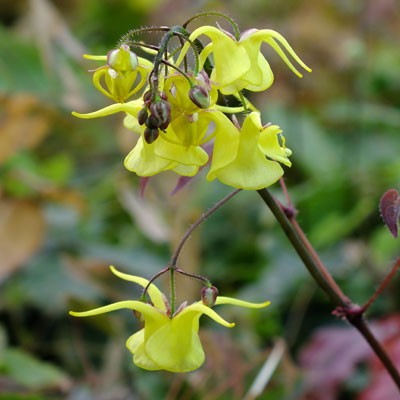-
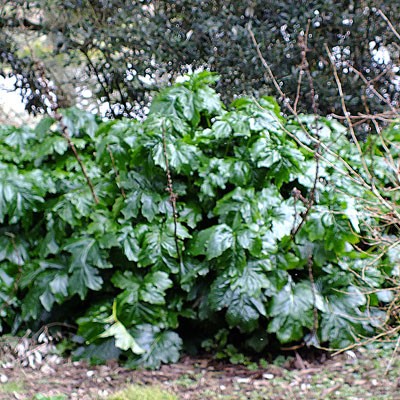
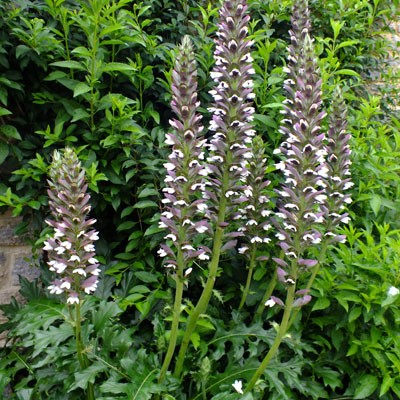
Potsize - 1L
Acanthus mollis . This is the classic Bear's Breeches that is so used in Classical decoration. Handsome deeply lobed leaves and stiff spikes densely packed with four rows of purple shrouded white flowers. This species is more open than its variety 'Latifolius' and paler in colour. Well drained soil in full sun; Height between 90 & 150cm Discount of 25p per plant for quantities of 3 or overLinks
Acanthus Compared
Botanical Style Photographs
-
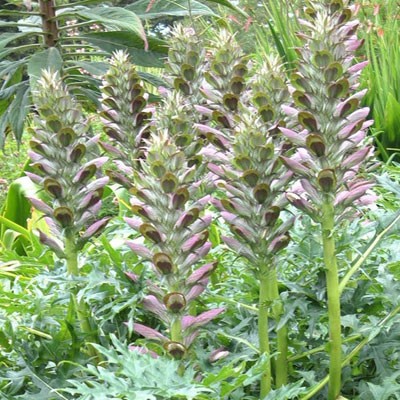
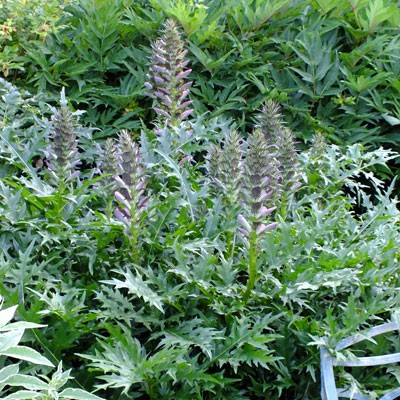
Potsize - 1L
(Acanthus caroli-alexandri) . Handsome plants with large shining ornamental foliage. This species has deeply divided glossy dark green leaves. Spires of hooded foxglove-like flowers in a two-toned purple and white. Height 4-5 feet. The foliage of Acanthus spinosus represents a midpoint between the less divided of Acanthus mollis and the extreme of spikiness, Acanthus spinosus Spinossissimus Group.Links
Acanthus Compared
Botanical Style Photographs
-
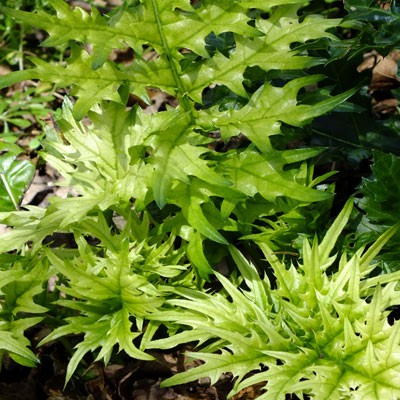
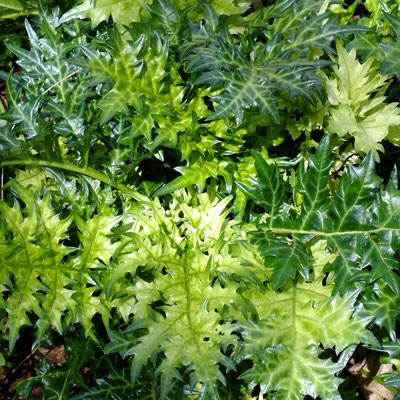
Potsize - 1L
Acanthus spinosus 'Lady Moore'. Handsome plants with large shining ornamental foliage. This species has deeply divided glossy dark green leaves, which in 'Lady Moore' are splashed and spotted cream in Spring when the plant is growing vigorously. Spires of hooded foxglove-like flowers. Height 4-5 feet. the cream variegation does not show up in potted plants.Links
Acanthus Compared
Botanical Style Photographs
-
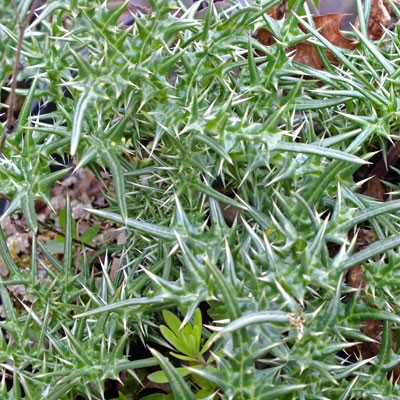
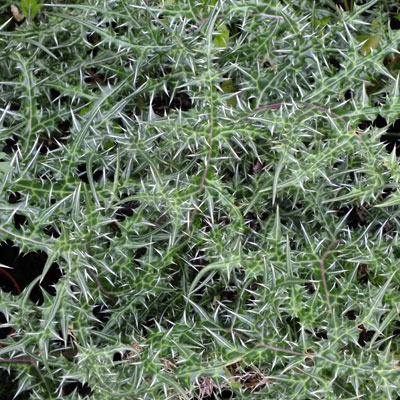
Potsize - 1L
The spiniest, prickliest form of Acanthus spinosus. The leaves are so finely cut that they are reduced to a veinal framework with every part of the leaf a handsome silver spike. It thrives in hot dry conditions although it flowers less precociously than the type. Still the foliage is amazing with its combination of dark green ground almost completely silvered over. It's ferocious mind - our neighbour grows it in his plant jail alongside his golden stinging nettle ! 75cmLinks
Acanthus Compared
Botanical Style Photographs
-

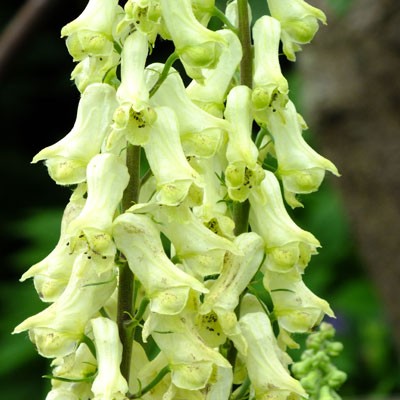
Potsize - 1L
Aconitum lycoctonum ssp. neapolitanum (lamarckii). WOLFSBANE. Tall stems with dense pyramids of narrow hooded flowers crowded higgledy-piggledy up the stem, each shaded ivory and green. Leaves are more palmate like a delphinium and less cut than other species. A real treasure for part shade. 5ft CAUTION - ALL PARTS OF THIS PLANT ARE POISONOUS Discount of 25p per plant for quantities of 3 or overLinks
Aconite Varieties Compared
Botanical Style Photographs
-
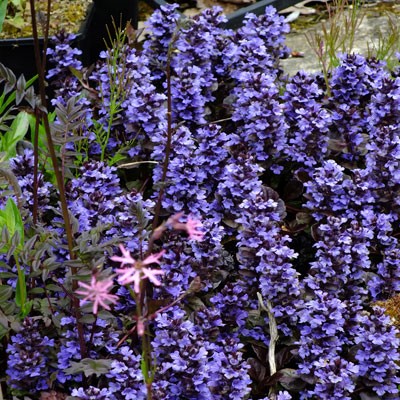
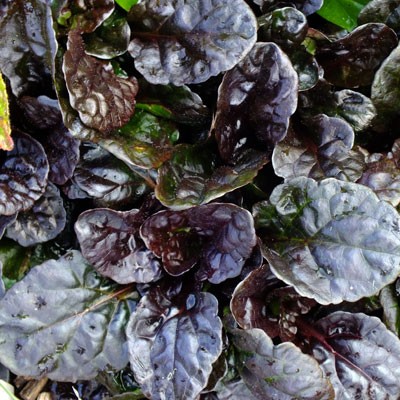
Potsize - 1L
Bugle. A good dark leaved variety with scalloped edged foliage. Lovely ground cover for a shady spot where the leaves will carpet. Flowers in short spikes above the foliage in Spring. Discount of 25p per plant for quantities of 3 or overLinks
Botanical Style Photographs
-
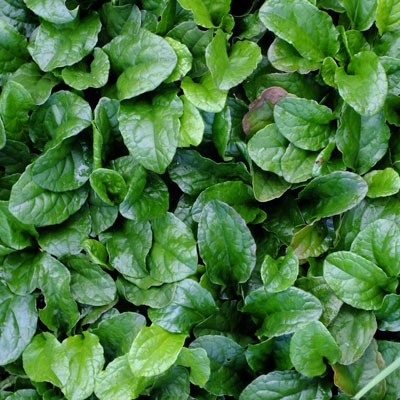

Potsize - 1L
Bugle. Lovely ground cover for a shady spot where the green leaves will make a dense carpet above which will stand dense, short spikes of pink flowers in the spring. Discount of 25p per plant for quantities of 3 or overLinks
Botanical Style Photographs
-
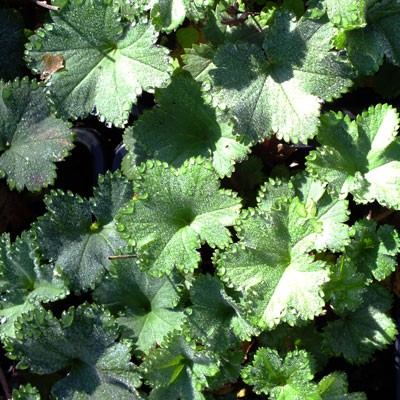


RHS AGM
Potsize - 1L
A smaller form of the otherwise similar Alchemilla mollis with beautiful scalloped, serrated edged foliage which often takes on a blueish-grey hue. Typical chartreuse sprays of flowers are produced in Summer on purply stems and act as a lovely foil to other blooms. Grows about 6 inches high and 8 inches wide and, apart from needing sun for at least part of the day, is very undemanding.Links
Alchemilla in the Garden
-

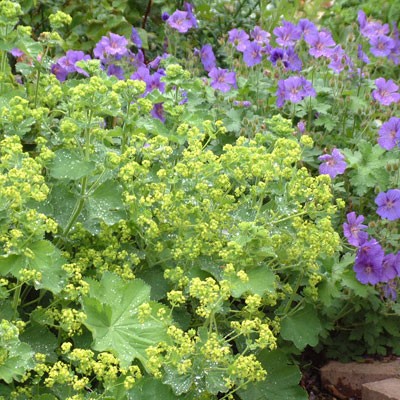
Potsize - 1L
Alchemilla mollis. Scalloped hairy leaves form a dense clump and are a delight when bejewelled with dew or raindrops. The flower heads are like a dense limey green gypsophila. A fantastic tough and rewarding plant that will grow happily in all but soggy sites, thriving in dry shade. It assorts remarkably well with so many other plants as well. The colour of the flowers of Alchemilla is derived from two rows of sepals, the flowers lack petals. Medieval alchemists believed the water droplets that collected in the centre of alchemilla leaves possessed magical and medicinal properties. The plant has a long tradition of being used to cure women's ailments and the plant was consequently named in dedication to the Virgin Mary. The leaves were seen as resembling a mantle (cloak). Alchemilla derives from the Arabic word 'alkimiya' = alchemy Discount of 25p per plant for quantities of 3 or overLinks
Alchemilla in the Garden
-
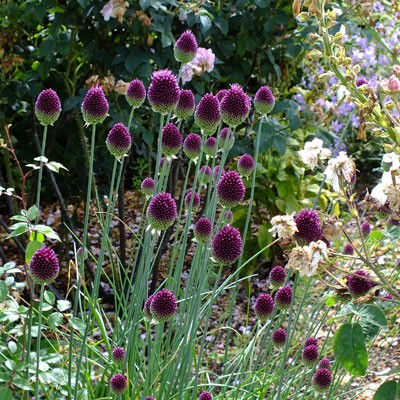
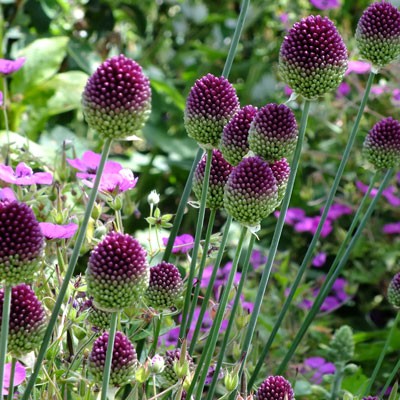
Potsize - 9cm
Allium sphaerocephalon. Pear-shaped heads, densely packed with flowers begin green and gradually turn a deep pinky-purple, the colour spreading from the top until the whole head is coloured. All the time the heads maintain their dense drumstick form, swaying on impossibly thin stems. Try naturalising in grass or in a prairie style planting. July. 60cm. From fields and dry verges from Britain, across Europe and North Africa to Israel.Discount of 25p per plant for quantities of 3 or over -

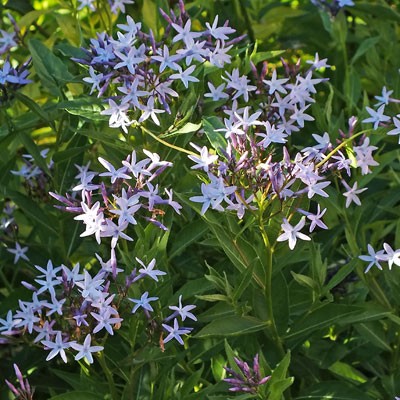
Potsize - 1L
This is a compact form growing just 35-40cm high with the deepest lavender-blue flowers of any Amsonia. It arose in a seedling batch of Amsonia tabernaemontana on a nursery in Connecticut and is thought to possibly be a hybrid with Amsonnia hubrechtii. It pays its way all year with neat shiny green leaves on a compact easy care plant, topped with flowers in June to July which emerge from long dark buds. It takes on lovely yellow Autumn colours in Autumn. Perfect as an edging plant. It does start off slowly but builds up stature year on year, rarely needing dividing. Good for butterflies and Deer resistant. -
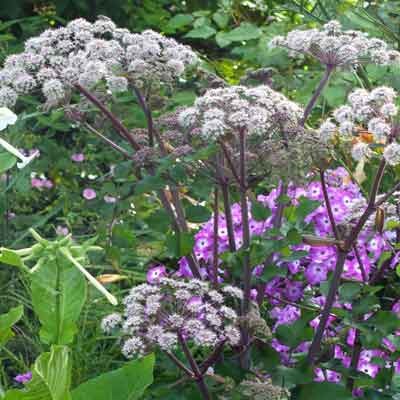
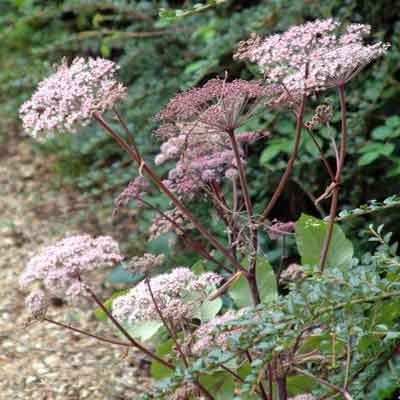

Bee Friendly
Potsize - 1L
Angelica sylvestris 'Purpurea' . Starting remarkably early in the year this plant pushes up fascinating glossy purple foliage, soon becoming an imposing architectural feature topped with a dense spherical head of pink flowers. In appearance not dissimilar to a more sturdy cow parsley, but with less air and more presence. Will seed about mildly. Likes a good moist spot. Discount of 25p per plant for quantities of 3 or overLinks
Umbellifers
-
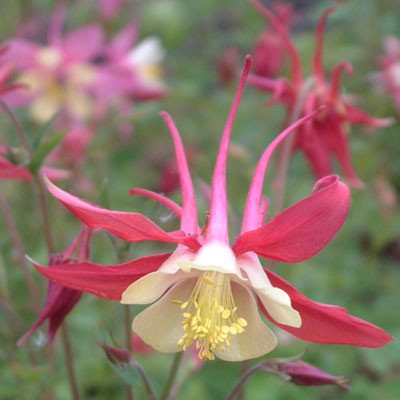
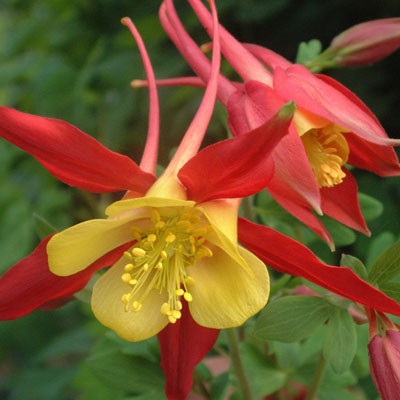
Potsize - 9cm
Aquilegia 'Koralle' An old cottage garden favourite and a good cut flower. Abundant display in late spring of long spurred red and yellow flowers over fine blue-green foliage. 80cm. Full sun. Medium height variety. A seed grown strain that might display some variation in colour and form. HARMFUL IF EATENDiscount of 25p per plant for quantities of 3 or more of this variety, 50p for 10 of any AquilegiaLinks
Aquilegia Compared
-


Potsize - 9cm
Aquilegia 'Yellow Star' (Star Series). An old cottage garden favourite and an excellent cut flower. Abundant display in late spring of long spurred two-toned lemon yellow flowers over fine blue-green foliage. Do not overcrowd the crown or allow other plants to flop over the foliage. 60cm. Full sun. HARMFUL IF EATENDiscount of 25p per plant for quantities of 3 or more of this variety, 50p for 10 of any AquilegiaLinks
Aquilegia Compared
-
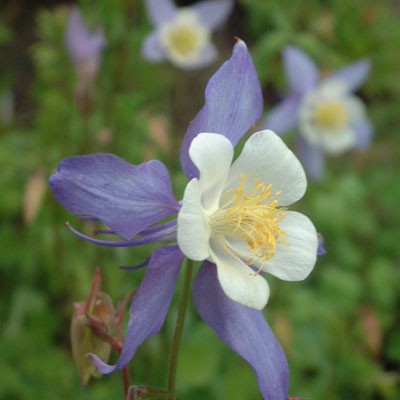

Potsize - 9cm
Aquilega 'Heavenly Blue' ('Sky Blue', 'Blue Dream'). A long spurred aquilega whose flowers are a rich cobalt blue with contrasting white corolla. A cottage garden favourite & an excellent and unusual cut flower. May to June. 85cm. A Medium height variety. allow some air around the crown. HARMFUL IF EATENDiscount of 25p per plant for quantities of 3 or more of this variety, 50p for 10 of any AquilegiaLinks
Aquilegia Compared
-
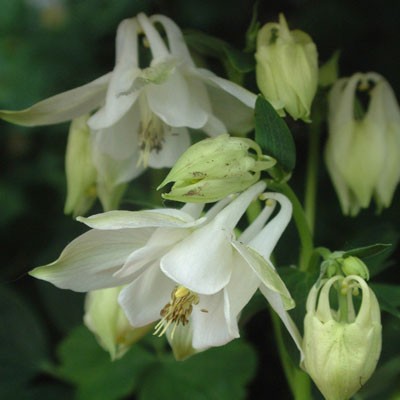
Potsize - 9cm
Large pure-white, gracefully nodding bonnets, each 4cm wide are borne on leafy stems 80cm high in great profusion. Often tipped with green on ageing, the spurs are short and slightly curled. The attractive divided foliage forms a basal clump of fresh apple-green, leafing up early in Spring to make a lovely foil for bulbs and early Primroses in the garden. They start pushing up flowering stems as early as April and go on producing a sequence of blooms until early June. They are deep rooted plants which seek water well and are therefore tolerant of dry shady conditions as well as full sun. The pure white blooms really lighten up a shady spot and look wonderful with cool greens and ferns. Although 'Munstead White' grows true from seed collected from isolated plants, Aquilegias are highly promiscuous members of the Ranunculaceae and will take any opportunity to mix their genes with their kin producing seedlings of a wide range of colours and spur lengths.Discount of 25p per plant for quantities of 3 or more of this variety, 50p for 10 of any AquilegiaLinks
Aquilegia Compared
-

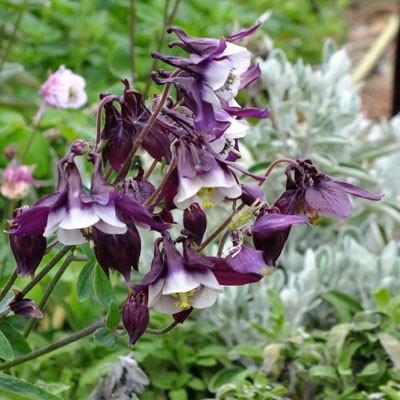
Potsize - 9cm
Aquilegia vulgaris 'William Guiness' ('Magpie') A recent introduction with striking flowers in bicolour white and deep purple (near black). The flowers are of traditional nodding A. vulgaris form with well flared petals and curve-tipped spurs. Would look good in a mixed cottagey border Best in light shade. 90cm HARMFUL IF EATENDiscount of 25p per plant for quantities of 3 or more of this variety, 50p for 10 of any AquilegiaLinks
Aquilegia Compared
-
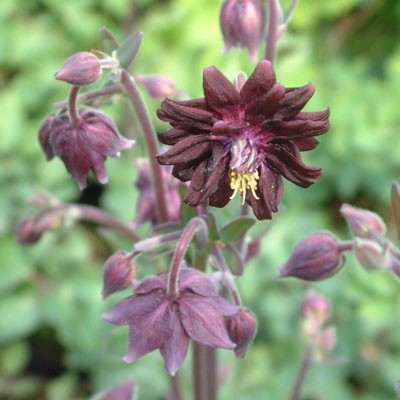
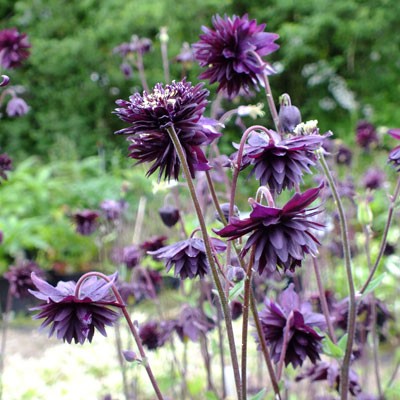
Potsize - 9cm
Aquilegia vulgaris var. stellata 'Black Barlow' (Barlow Series). One of the spur-less Barlow series based around the plant originally found in the garden of Nora Barlow. This form has flowers that are a deep dusky maroon. Would look good in a mixed cottagey border, hanging above paler mounds of flowers. Best in light shade. HARMFUL IF EATENDiscount of 25p per plant for quantities of 3 or more of this variety, 50p for 10 of any AquilegiaLinks
Aquilegia Compared
-
Sale!
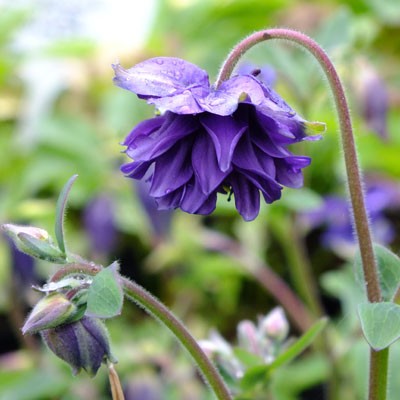
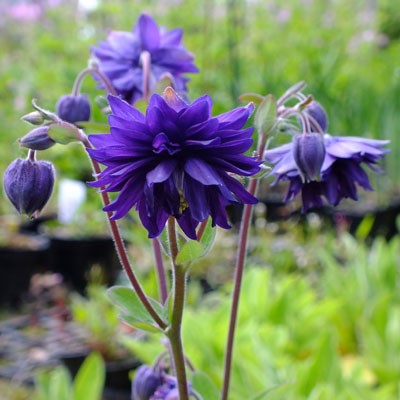
Potsize - 9cm
One of the spur-less Barlow series based around the plant originally found in the garden of Nora Barlow. This form has flowers that are a violet-blue. Would look good in a mixed cottagey border, hanging above paler mounds of flowers. Best in light shade. HARMFUL IF EATENDiscount of 25p per plant for quantities of 3 or more of this variety, 50p for 10 of any AquilegiaLinks
Aquilegia Compared
-

Potsize - 9cm
A fitting name for this richly claret coloured, very double. Spurless Aquilegia. A tall elegant variety with strong stems. 60-90cmDiscount of 25p per plant for quantities of 3 or more of this variety, 50p for 10 of any AquilegiaLinks
Aquilegia Compared
-
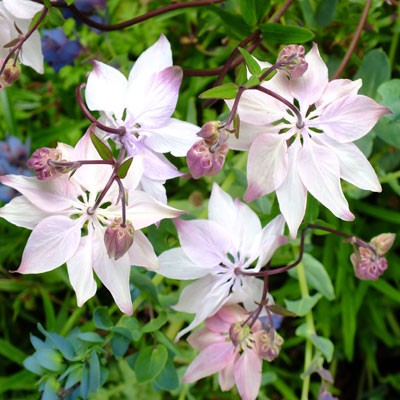

Potsize - 9cm
Aquilegia vulgaris var. stellata ( A. clematidiflora ). A variation on an old cottage garden classic. This is the root of all of those double flowered forms that you find under the 'Barlow' banner. It is a lovely thing, having quite flat flowers, lacking the usual Aquilegia spurs, and having more than a passing resemblance to a clematis. The stems are tall and all the pale fleshy-pink flowers look down so that you look on the backs of the flowers. easy and well worth squeezing into a mixed bed. Will freely seed about in any well drained soil and cheer any planting in late spring with its wonderful array of pastel flesh pink blooms. Any soil that is not too wet. full sun. 60cmDiscount of 25p per plant for quantities of 3 or more of this variety, 50p for 10 of any AquilegiaLinks
Aquilegia Compared
-
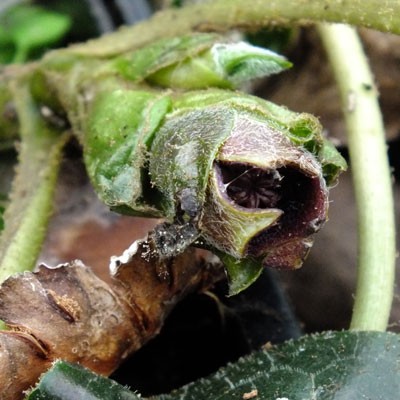
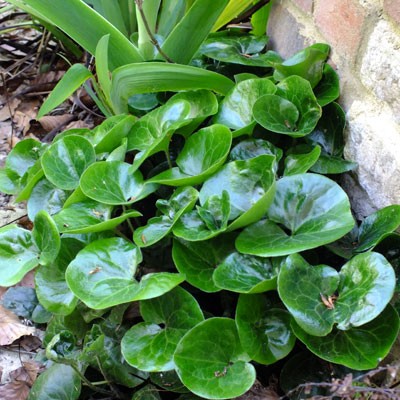
Potsize - 1L
Asarum europaeum - Asarabacca. Shining evergreen foliage interest for moist shade where creeping rooting stems form loose ground cover. Curious fly pollinated flowers appear in spring. Asarum europaeum - Asarabacca - may not be the most showy but everything about it cries out class. The leaves are a lovely glossy deep green and evenly rounded, the perfect counterpart to filigree plants like Maidenhair ferns. It will grow in dry shaded locations where it will make good groundcover and if you care to lower your nose to it you'll catch a rich spicy aroma. It is certainly one of my favourites. CAUTION. All parts of this plant are poisonous. -
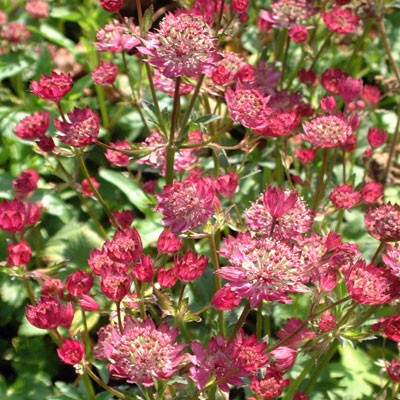
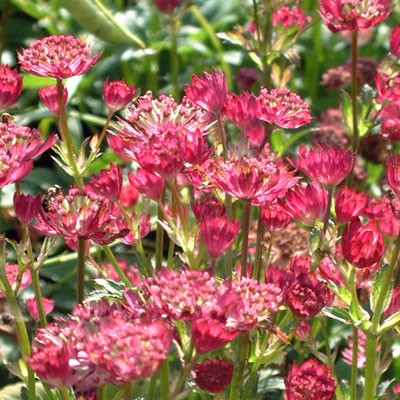
Potsize - 1L
A recently selected large flowered dark red masterwort. Tight clusters of maroon flowers are surrounded by beautiful ray florets. An interesting & beautiful plant happy in sun or part shade with some drainageLinks
Astrantia Compared
Astrantia in the Garden
Botanical Style Photographs
-
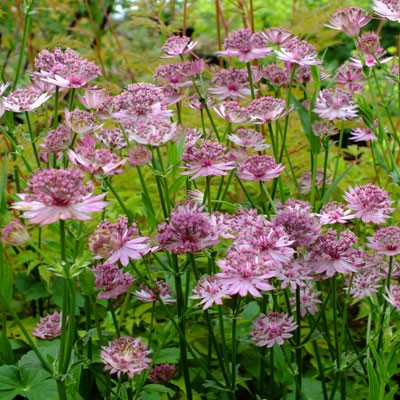
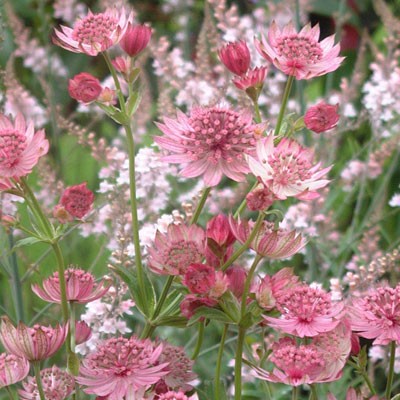
Potsize - 1L
Astrantia 'Roma'. Lovely mid pink cultivar of good constitution. The bracts form a shallow starry cup that is a shade lighter than the tight central pincushion of true flowers. 60cm. An interesting & beautiful plant Happy in sun or part shade with some drainageLinks
Astrantia Compared
Astrantia in the Garden
Botanical Style Photographs
-
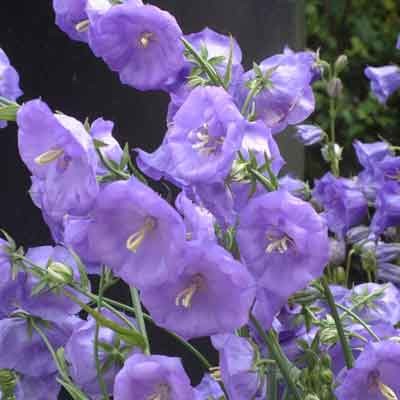
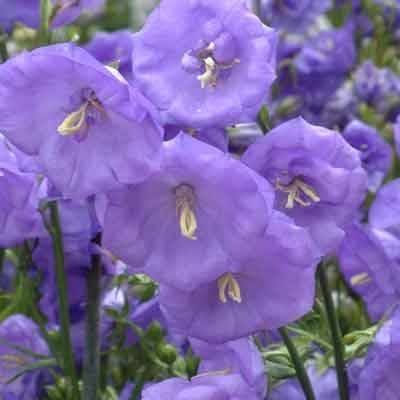
Potsize - 1L
Campanula persicifolia 'Blue Bloomers'. A blooming good variety with large flowers that are more saucer shaped than the type. They are a good strong blue and have a extra set of petals creating a hose in hose bloom. One of the taller varieties. Evergreen foliage. Good on chalky soilsDiscount of 25p per plant for quantities of 3 or overLinks
Campanula Compared
Botanical Style Photographs
-
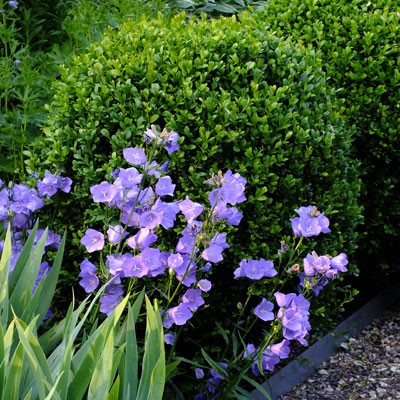
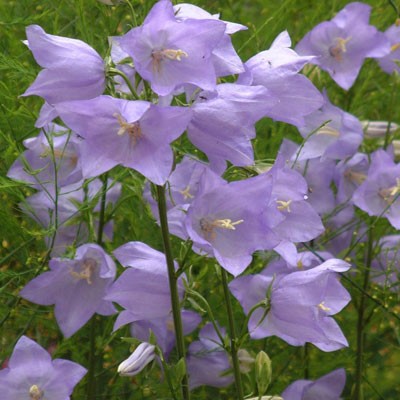
Potsize - 1L
Campanula persicifolia 'Grandiflora'. Like a large version of a harebell Dense clumps of foliage and a succession of sky blue bells. Height 80cm Excellent cut flower. Good on chalkDiscount of 25p per plant for quantities of 3 or overLinks
Campanula Compared
Botanical Style Photographs
-
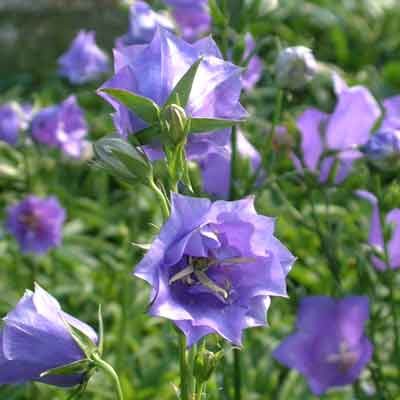

- Bee Friendly
- RHS AGM
Potsize - 1L
The flowers of this beautiful variety are well cupped with a second inner cup that is ruched, giving a quite double impression. The colour is a strong violet blue which, coupled with a relatively dense habit and closely spaced flowers, makes for a most striking variety. Height 80cm Excellent cut flower. Good on chalk. Possibly the shortest of the C.persicifolia varieties and one of several different plants introduced with the name 'Pride of Exmouth' by the Exmouth based Horticulturalist and Seedsman WJ Godfrey FRHS FNCS (1858-1927). One of his last introductions, coming to the trade not long before the end of his life.Discount of 25p per plant for quantities of 3 or overLinks
Campanula Compared
Botanical Style Photographs
-
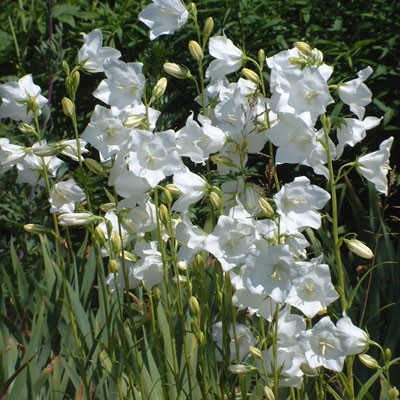
Potsize - 1L
Campanula persicifolia 'Alba'. The large bells of this variety are a pure glistening white. A real elegant flower that associates well with greens and blues, lifting any scheme it is planted in. Height 80cm Excellent cut flower. Good on chalk. Can be grown in shade.Discount of 25p per plant for quantities of 3 or overLinks
Campanula Compared
Botanical Style Photographs
-
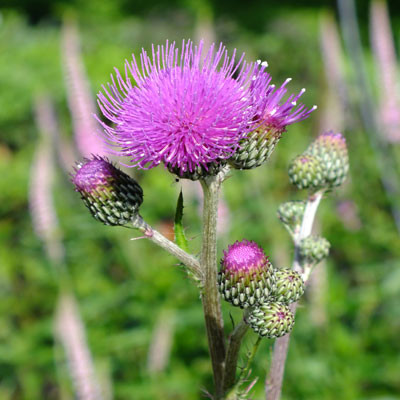

- Butterfly Friendly
- Bee Friendly
Potsize - 1L
Queen Anne Thistle. This is a native thistle from Europe, being found right across into Russia. It's no shrinking violet, but unlike some of the other members of the Cirsium genus it tends to stay put in one place and not become 'weedy'. It grows a generous basal rosette of largely non-spring leaves and throws up tall branching flower spikes up to 2m plus topped with generous thistle-knobs at the top. If you have the space its a great statement plant and great too for the wildlife, providing nectar for insects, seeds for the finches and a food plant for Painted Ladies. For a moist soil.Discount of 25p per plant for quantities of 3 or overLinks
Botanical Style Photographs
-
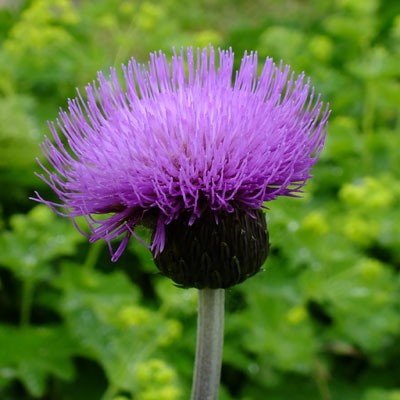
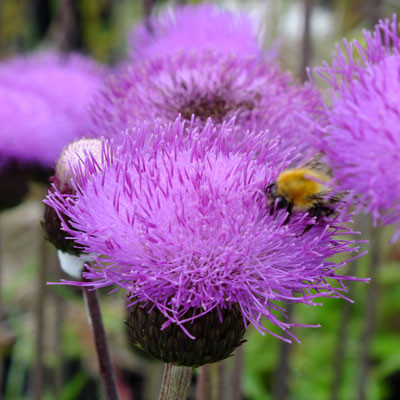
- Butterfly Friendly
- Bee Friendly
Potsize - 1L
Melancholy Thistle. Broader leaves, a more spreading habit and larger flowers than its cousin Cirsium rivulare. Later in the year to flower as well. The reason for the name heterophyllum comes from the variability of the leaf form, which becomes more divided on the flowering stalks than the basal rosettes. In shade this plant will grow well but flower poorly. Give it plenty of moisture and sun to see it at its best. The plant was considered a possible cure for sadness. Nicholas Culpepper in 1669 said that it "makes a man as merry as a cricket" Discount of 25p per plant for quantities of 3 or overLinks
Botanical Style Photographs
-
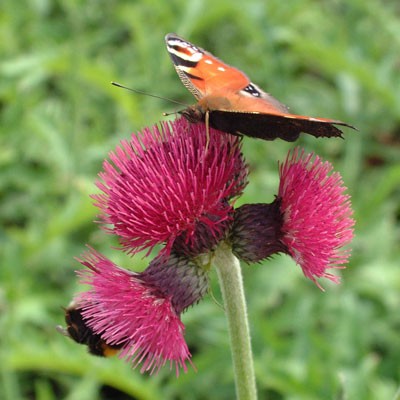
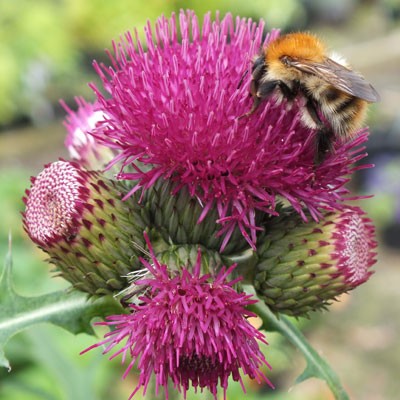
- Butterfly Friendly
- Bee Friendly
Potsize - 1L
Cirsium rivulare 'Atropurpureum'. Attractive thistle with stout erect flowering stems generously topped with rich red-purple thistle knobs. Easy and rewarding plant with strong architectural character. Grows best with moisture. 1m. June and then sporadically afterwards. A Magnet for bees and butterflies Discount of 25p per plant for quantities of 3 or overLinks
Botanical Style Photographs
-
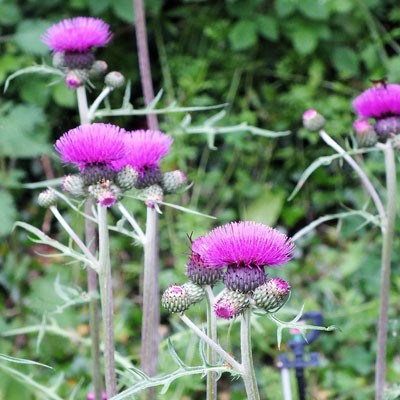

- Butterfly Friendly
- Bee Friendly
Potsize - 1L
Cirsium rivulare 'Trevor's Blue Wonder'. A new variety that compliments its similar cousin C.rivulare 'Atropurpureum'. Whilst being superficially similar it has flowers that are bluer in hue and are carried on stems that are purple stained over white pubescence. A little stiffer and more vigorous in growth. Like all Thistles, the flowers are a magnet for butterflies. 1m, May-June and then sporadically through the season. Would like a moist site. Discount of 25p per plant for quantities of 3 or overLinks
Botanical Style Photographs
-

Potsize - 9cm
Convallaria majalis. Lily-of-the-Valley. One of those perennials that really needs no introduction. It is native to Britain and is particularly common on Lime rich soils, growing thick tangled mats of root in woodland situations. Each node produces two broad leaves in the middle of which nestle the stiff little spikes hung on One side with little fragrant white bells, Each with a narrowed frilly opening like an old-fashioned maids bonnet. Lily-of-the-Valley is easily grown and adaptable and particularly suited to leaving alone in difficult dry situations where It will happily carpet and provide fragrant little posies Each SpringDiscount of 25p per plant for quantities of 3 or overLinks
Lily-of-the-Valley - Botanical Style Photographs
-
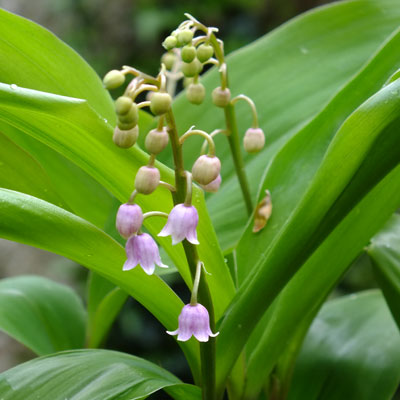

Potsize - 1L
This is the pink flowered form of Lily of the Valley. I recently read it described as 'a stunning new variety' but I'm going to resist such hyperbole. It is pleasant and different with a subtle, if a liitle dull, pink shading on the outside of each bell. The leaves are a little bluer in shade as well. Its a great addition to a collection and I don't want to denegrate its charms, just don't ecpect to have your socks blown off and you'll be well pleased.Discount of 25p per plant for quantities of 3 or overLinks
Lily-of-the-Valley - Botanical Style Photographs
-
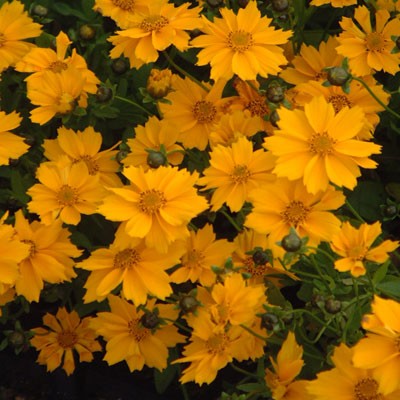

Potsize - 1L
Coreopsis auriculata 'Zamphir' is a bright ray of sunshine for early summer. A spreading clump former for the front of the border which will delight with a dense covering of 5cm rich yellow daisy flowers. 30cm. Keep dead-heading to keep the flowers coming.Discount of 25p per plant for quantities of 3 or over -

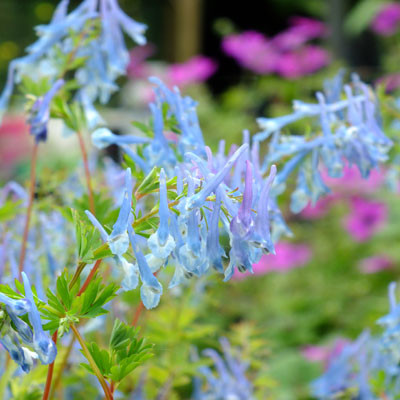
Potsize - 1L
A cross between Corydalis fleuosa and Corydalis omeniana from Ian Young's garden in Aberdeen. Vigorous clumps of limey, chartreusy-green juicy fern-like foliage over which come the strongly scented sky-blue flowers. Like Corydalis elata, but smaller and colouring only very slightly in the stems. Wintergreen and very hardy if grown in a moisture retentive soil which is not over wet and doesn't dry out in the Summer. Divide every three years to maintain vigour and encourage the best flowering. Flowers from Spring until June. 30cmLinks
Corydalis Compared
-
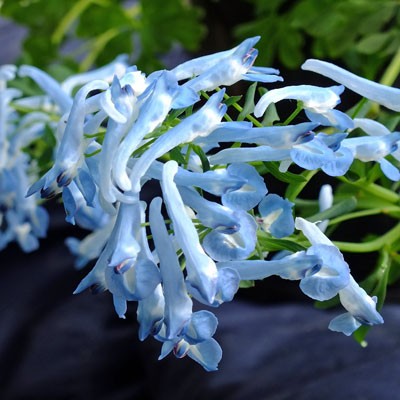

Potsize - 1L
A new repeat flowering variety with intense bright deep turquoise blue flowers that can appear from Early Summer right through until Autumn if moisture remains present. A hybrid of Corydalis flexuosa and Corydalis cashmeriana produced by Keith Lever. Short at 20-30cm. A short variety that retains the compact charm of C.cashmeriana but with a greater degree of vigour. Almost evergreen, taking on good colour in the flower stems with adequate moisture throughout the season.Links
Corydalis Compared
-
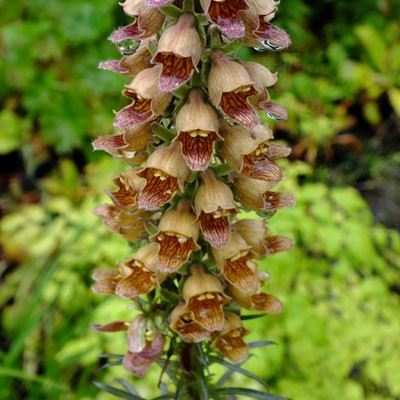
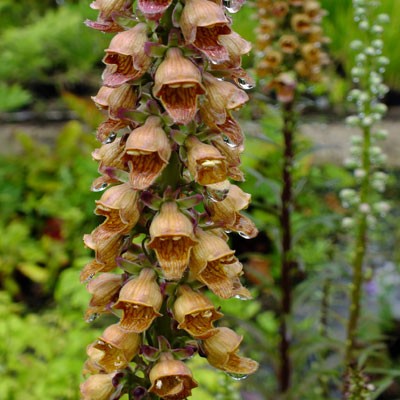
- Bee Friendly
- RHS AGM
Potsize - 1L
Digitalis ferruginea 'Gelber Herold' (Yellow Herald) . Immaculate evergreen glossy rosettes of long, narrow dark green leaves are a feature all year. The flowers spikes are tall, stiff and densely crowded with charming ochre, yellow-lipped flowers arranged all around the stem in perfect regularity. More yellow in the flowers than the species. 4ft CAUTION- TOXIC IF EATENDiscount of 25p per plant for quantities of 3 or overLinks
Foxgloves Compared
-
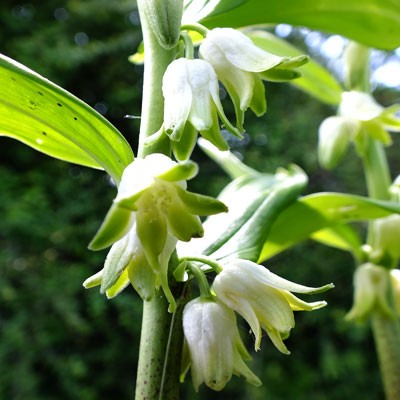

Potsize - 1L
Disporopsis pernyi - Evergreen Solomon's Seal. A relative of the solomon's seal, this spreading perennial has dark green leaves and hanging flared bells that are said to have a lemon scent, but I get more of a nutmeg vibe. A graceful plant for shade. This plant is a long time in bud before the flowers open which is really rather pretty. 60cmDiscount of 25p per plant for quantities of 3 or overLinks
Botanical Style Photographs
-
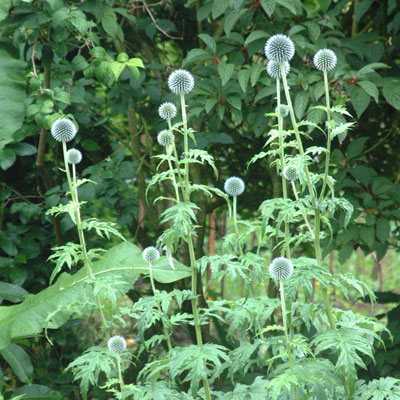
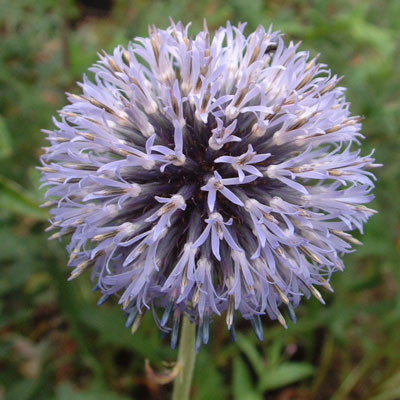
Potsize - 1L
Hungarian Globe Thistle. An intensely blue selection of this species, said to be far superior to forms of Echinops ritro. Large too, flowering at 120cm tall. Flowers from July to October. The species originates from Central to Eastern Europe through to Asia Discount of 25p per plant for quantities of 3 or over -

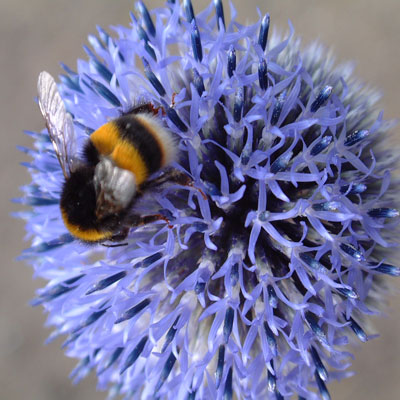
Potsize - 1L
Echinops tenuifolius. This species was singled out by William Robinson as the most magnificent in its family. The foliage is the finest, being more finely divided than other and it is a stark white on the reverse. The stems also are white woolly. Flower heads start off as spiky silver balls, becoming brilliant bright blue when the flowers are fully open. On the shorter side at 60cm and flowering from July to September. The species from Southern and Eastern Europe across to Russia and China. Discount of 25p per plant for quantities of 3 or over

















































